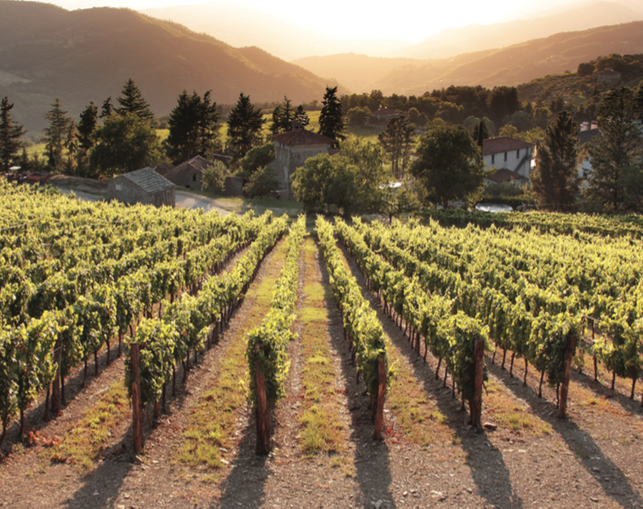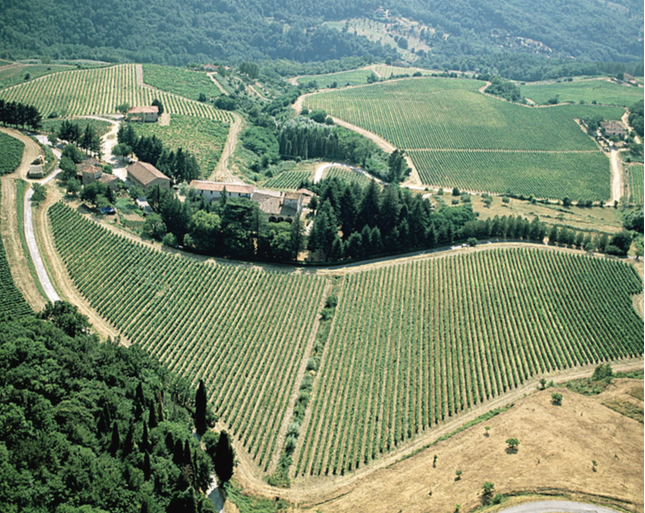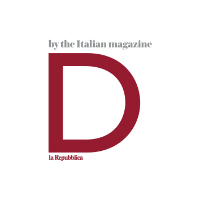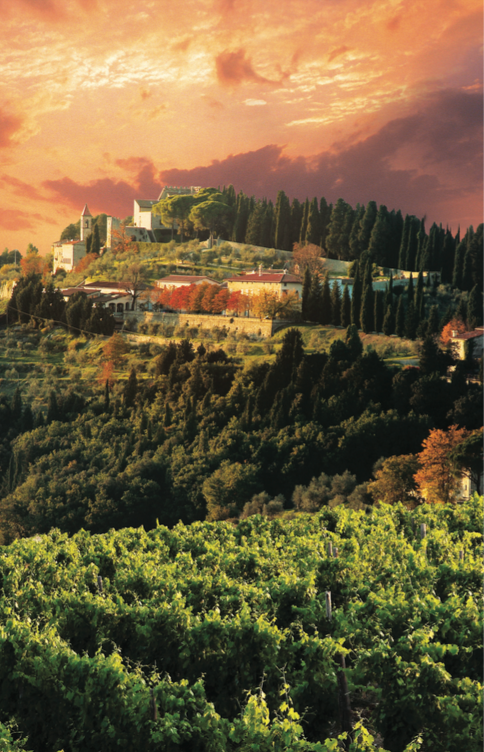
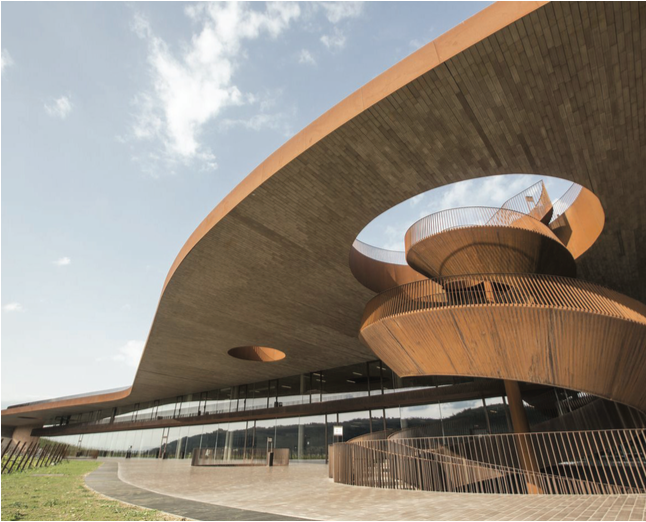
The founder of the Antinori family was Rinuccio, documented as far back as 1180, but the marquises proudly point out that their family tree includes Giovanni di Piero. In 1385 he became part of the Arte dei Vinattieri, Florence’s guild of winemakers, and launched a production history that has come down through six centuries and 26 generations. Today, the company— which boasts the famous Tignanello and Solaia among its wines—is headed by Marquis Piero and his daughters Albiera, Allegra and Alessia. In the Chianti Classico area it owns large estates such as Tignanello and Passignano, as well as the more recent and futuristic Cantina del Bargino. The estates of the Marchesi de’ Frescobaldi are equally famous and enchanting. Long present in Florence’s Oltrarno district—on the south side of the river—in the magnificent palazzo bearing their name, the Frescobaldi family owns a restaurant in Piazza della Signoria and six magnificent Tuscan estates, from the ultramodern Cantina dell’Ammiraglia in the Grosseto area to Castel Giocondo in Montalcino. But the heart of their centuries of winemaking history is Chianti Rufina, with a landscape that is almost Apennine in appearance, dotted with woods, vineyards and castles.
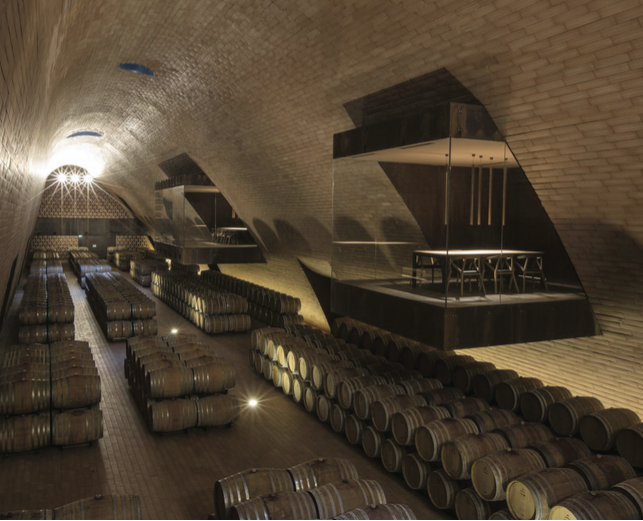
The production of the company, now headed by Marquis Lamberto, concentrates on important crus— wines that come from a single vineyard—like Montesodi and Mormoreto, and extraordinary classic DOCGs like Pomino and Nipozzano, produced on the estates of the castles by the same name that have always been owned by the family. With an eye to experimentation and development, the Frescobaldi family is currently investigating the possibility of planting new vineyards on the island of Pianosa, in the Tuscan archipelago that was already famous for its wine in Roman times. And, naturally, under the banner of a single mission: “Cultivating Tuscan Diversity.”
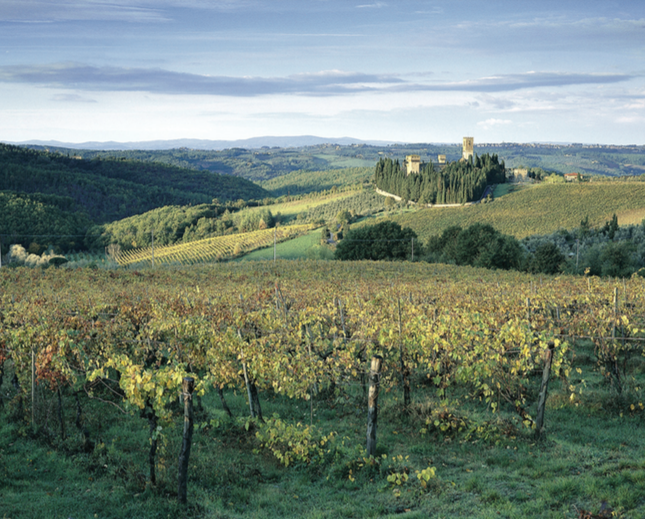
THE TUSCANY OF NOBLE WINES
1. CANTINA ANTINORI NEL CHIANTI CLASSICO
A majestic work of architecture and design with the latest technologies, Cantina Antinori nel Chianti Classico in the town of Bargino, just a few kilometers from Florence, was designed by the Florentine studio Archea Associati. This true “city of wine” wedged under a hill and covered with vineyards was inaugurated in 2012. It presents the entire vinification process, but also has public venues such as an auditorium and a museum about the Antinori family’s centuries of winemaking. The restaurant Rinuccio 1180, with its magnificent terrace, offers visitors the chance to taste and buy Antinori’s prized wines, including the famous Solaia and Tignanello, paired with seasonal traditional Tuscan dishes. Guided tours are offered daily but reservations are required. CANTINA ANTINORI NEL CHIANTI CLASSICO, Via Cassia per Siena 133, Loc. Bargino – 50026 San Casciano Val di Pesa (FI), tel. +39 055 2359700, www. antinorichianticlassico.it
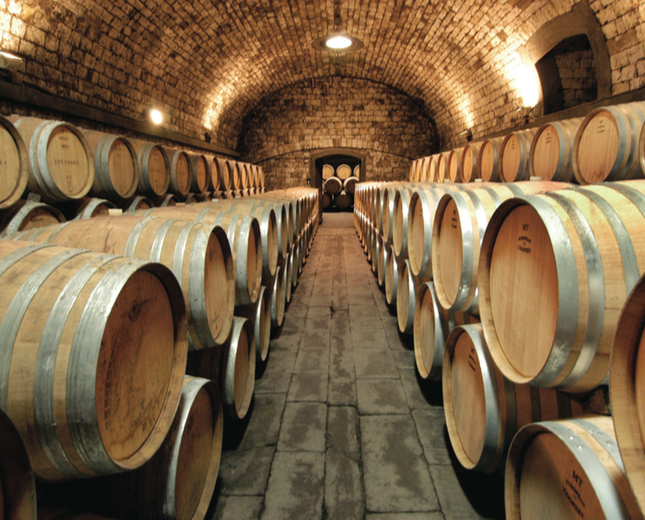
2. BADIA A PASSIGNANO
The Vallumbrosan monastery of Badia a Passignano, built before the year 1000, offers an extraordinary exploration of the most authentic Tuscany. At Passignano there is an inn with a shop where visitors can purchase the entire production of the Marchesi Antinori, owners of the sprawling vineyards surrounding the religious complex. The ancient cellars of the abbey, with wine tastings, can be visited on request. This is where the Marchesi Antinori Chianti Classico DOCG Badia a Passignano is made.
Bottega e Osteria di Passignano, Via Passignano 33, bc. Badia a Passignano, 50028 Tavarnelle Val di Pesa (FI), tel. / fax +39 055 8071278, www.antinori.it
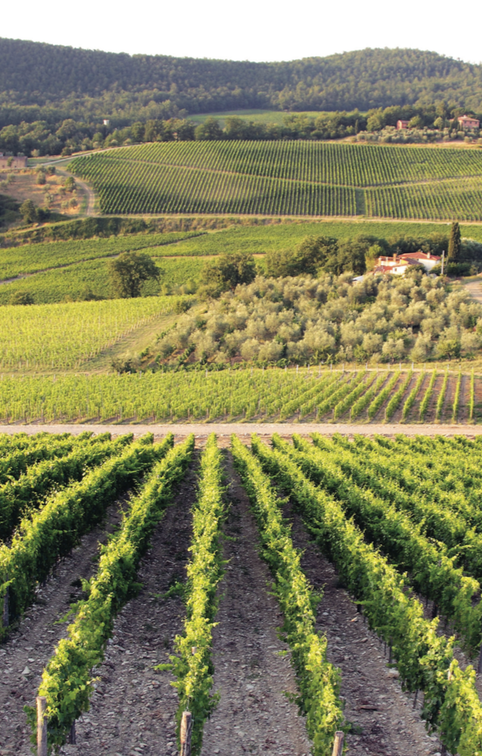
3. CASTELLO DI NIPOZZANO
The gem of the Marchesi de’ Frescobaldi, the Castle of Nipozzano dates back to the year 1000 and is in the Chianti Rufina area, east of Florence, on the last offshoots of the Apennines facing the Arno. The vineyards of this estate yield the crus Montesodi and Mormoreto, as well as the Chianti Rufina Reserve DOCG Nipozzano and Nipozzano Vecchie Viti. The castle has a restaurant offering wine tastings and Tuscan cuisine, but starting in May it will also be possible to spend the night. The charming old wine cellars can be visited by small groups, but strictly by reservation.
Castello di Nipozzano, Via di Nipozzano, Nipozzano, Pelago, 50060 (FI), tel. +39 055 8311050, www.frescobaldi.com
4. CASTELLO DI POMINO
In the woods of the Florentine mountains, with vines growing at altitudes of up to 2,300 feet, the Renaissance Tenuta di Pomino produces some of the most famous wines of the Marchesi Frescobaldi: Leonia, Benefizio, Pomino Pinot Nero, Pomino Bianco, Pomino Vin Santo, Vendemmia Tardiva. The castle dates back to the early 16th century and has five rooms for a relaxing and exclusive stay, with the chance to learn about and taste Frescobaldi wines, paired with the finest traditional Tuscan dishes. The wine cellars can be visited on request and strictly by reservation. Castello di Pomino, Località Pomino, 80, 50068 Rufina (FI), tel. +39 055 8311050, www. frescobaldi.com
